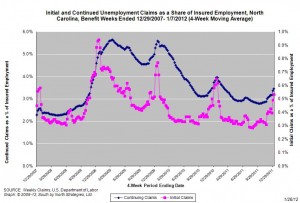26.01.2012
Policy Points
Economic policy reports, blog postings, and media stories of interest:
26.01.2012
Policy Points
For the benefit week ending on January 7, 2012, some 18,447 North Carolinians filed initial claims for state unemployment insurance benefits, and 130,450 individuals applied for state-funded continuing benefits. Compared to the prior week, there were fewer initial and continuing claims. These figures come from data released by the U.S. Department of Labor.
Averaging new and continuing claims over a four-week period — a process that helps adjust for seasonal fluctuations and better illustrates trends — shows that an average of 19,380 initial claims were filed over the previous four weeks, along with an average of 129,096 continuing claims. Compared to the previous four-week period, the average number of initial claims was higher, as was the average number of continuing claims.
One year ago, the four-week average for initial claims stood at 22,567 and the four-week average of continuing claims equaled 142,397.
In recent weeks covered employment has increased slightly and has returned to the 3.7 million level recorded a year ago. Nevertheless, there are still fewer covered workers than there were in January 2008, which means that payrolls are smaller today than they were almost three years ago.

The graph shows the changes in unemployment insurance claims measured as a share of covered employment in North Carolina since the recession’s start in December 2007.
Both new and continuing claims appear to have peaked for this cycle, and the four-week averages of new and continuing claims have fallen considerably. Yet continuing claims remain at an elevated level, which suggests that unemployed individuals are finding it difficult to find new positions.
26.01.2012
Policy Points
From the Federal Reserve Bank of Richmond’s latest survey of service-sector activity in the South Atlantic (District of Columbia, Maryland, North Carolina, South Carolina, Virginia and West Virginia):
Service sector activity continued to improve overall in January, according to the latest survey by the Federal Reserve Bank of Richmond. Retail sales accelerated, despite a sharp fall in big-ticket sales and declining shopper traffic. Retailers’ inventories grew more quickly this month. Revenues at non-retail services providers also advanced, although somewhat more slowly than a month ago. Retail merchants were generally more cautious in their outlook for sales over the next six months, while services providers expected increased demand for their services.
…
In service sector labor markets, hiring slowed slightly at non-retail firms and retailers cut workers. Average wage growth slowed at services businesses. At retail establishments, average wages declined.
…
Price change in the overall service sector slowed slightly, compared to a month ago. Survey participants expected slightly faster price growth in the next six months, compared to their expectations in December.
25.01.2012
Policy Points
Economic policy reports, blog postings, and media stories of interest:
25.01.2012
Policy Points
From the Federal Reserve Bank of Richmond’s latest survey of manufacturing activity in the South Atlantic (District of Columbia, Maryland, North Carolina, South Carolina, Virginia and West Virginia):
Manufacturing activity in the central Atlantic region advanced somewhat faster in January after firming somewhat in December, according to the Richmond Fed’s latest survey. All broad indicators — shipments, new orders and employment — landed in positive territory, with manufacturers noting their first increase in worker numbers since September 2011. Most other indicators were also positive, including capacity utilization. Only backlogs inched lower. Delivery times were virtually unchanged, while finished goods inventories grew at a slower rate.
…
Looking forward, assessments of business prospects for the next six months were more optimistic in January. Contacts at more firms anticipated that shipments, new orders, backlogs, capacity utilization, and capital expenditures would grow more quickly during the next six months.


 Email Sign-Up
Email Sign-Up RSS Feed
RSS Feed